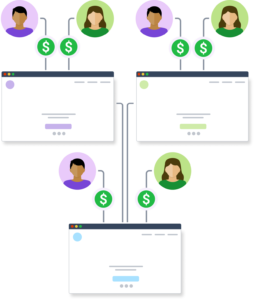Think Small to Win Big: Microphilanthropy for Nonprofits


Think of philanthropy—what comes to mind? An oversized check for millions of dollars from a white-haired billionaire? A wealthy benefactor’s name on the front of a university building? Leaving your entire estate to a charity that makes wigs for bald cats?
In an era of evolving technology and shifting demographics, philanthropy is changing. Sure, 88% of donation revenue comes from only 12% of donors, but the Millennial population bomb has already exploded. Millennials now outnumber Baby Boomers in the US, and they don’t like to give the old-fashioned way.
Younger donors prefer to use modern technology (like smartphones), they’re on social media, they want to understand the impact they are making, they don’t care much about tax benefits, and ultimately, they just don’t have the same level of financial resources as previous generations. Millennials give $580 on average to nonprofits each year; significantly less than older generations.
So if the days of fat checks and high-profile giving are waning, what comes next? Enter the rise of micro philanthropy for nonprofits.
What is Microphilanthropy?
It’s philanthropy for ants, right?
No, microphilanthropy is for the people – literally. It’s the democratization of giving by opening up philanthropy to nearly everyone regardless of socioeconomic status thanks to micro-donations. These are gifts between $0.25 and $25, and opportunities to give are everywhere: the grocery store, online fundraising, through your smartphone, even rounding up at the drive-thru. Micro-donations for nonprofits are so small that many donors give them without a second thought.
Microphilanthropy has been enabled largely by advances in technology. Transaction fees are much lower today thanks to innovative processing platforms like Stripe and Paypal (both of which integrate with Keela), making collecting donations possible without giving the goose away to the credit card companies. Plus, since so many of us are walking around with smartphones, we are almost always connected to nonprofit calls-to-action, mobile payment methods, and information about causes.
Micro-donations for nonprofits work because they are affordable. Younger donors want to contribute to causes they believe in, and people love, love, love an impulse buy. Why else would they put all the chocolate next to the checkout?
What Can Micro-Donations Do for Your Nonprofit?
As a nonprofit organization, why on earth would you bother with a 25 cent donation? Well, you’re just not thinking big enough when it comes to small donations.
Reach New Donors
Micro-donation fundraising campaigns are likely to reach potential donors outside your usual prospects. Whether it’s at the grocery store or on a social network, your small ask will be seen by a diverse group of potential donors who are outside your typical audience. So even if they’re only giving very small amounts, it means your message is getting farther out into the world, and that’s always going to be good for your organization.
Build Long-Term Support
Every donor that you reach, regardless of the amount of their donation, is a potential lifelong supporter. A $5 donation through Facebook is an introduction to your organization; with the right stewardship, that small donor could become a recurring supporter who gives for years, outpacing larger one-time donors when measuring lifetime value.
Plus, since you’re more likely to reach younger donors with microphilanthropy campaigns, especially the extremely tech-savvy Generation Z, you are onboarding potential lifetime donors at an earlier stage, hopefully introducing them to decades of impactful giving.
Diversify Your Revenue
Relying on just a few sources of revenue can be a precarious situation for nonprofit organizations. Even though the individual donations may be small, raising funds from micro-donors can help to diversify your revenue stream, helping your organization to stay somewhat insulated from changing economic conditions. Since micro-donations come from people across many different demographics, changes in giving behavior are less likely to affect all of them, ensuring at least some income is still on its way to you.
Get a handle on your nonprofit revenue with the Fundraising Forecasting Tool
Everyday Giving
Almost a third of total nonprofit giving happens in December. Wouldn’t it be nice to stretch that out over the year a little more evenly?
Micro-donations can help with that since they rely to a certain extent on giving in the moment (impulse buying behavior) rather than the spirit of the holiday season (or maybe the spirit of the coming tax season, it varies). So while chances are you’re still going to see most of your donations toward the end of the year, micro-donations can supplement your revenue all year long.
Raise More Money
Let’s build on the democracy metaphor from earlier: just like one vote, one small donation isn’t going to change the world. But a lot of votes, or a lot of small donations, can add up to a sea of change. Just look at what microphilanthropy did after the Haiti earthquake in 2010: nonprofit fundraisers collected over $30 million from text message donations alone.
So it’s good to keep in mind that even though a $2 donation isn’t very much by itself, lots and lots of $2 donations can significantly affect your bottom line.
See How Nonprofits Use Keela to Raise 4x More!
Get a glimpse of how Keela’s donor management system can help you develop better relationships, retain donors and raise more for your cause.
6 Tips to Encourage More Micro-Donations
On its own, choosing a payment processor with a low fee isn’t enough to get your microphilanthropy program off the ground. You’ll need to treat it like any other marketing campaign that you might run for your organization. Start by planning your attack, and take into account these helpful tips when deciding how to attract more micro-donations.
Tip 1: Target Locked
While a scattershot approach may get you some results, the better practice is to target demographics that are the most likely to make micro-donations. Which is to say, Millennial and Gen Z donors.
As we’ve discussed at length previously, donors in these generations want to be reached where they already are: social media, email, online, and on their smartphones. They don’t want phone calls or snail mail. And they want to feel like their donations, no matter how small, are making a difference.
Do your best to think about where you’re reaching out (try universities, video game streaming sites, and Tik Tok instead of Facebook, for example), and what kind of information you’re sharing about the impact of a donation. Keep your messaging short, sweet, and searchable—remember that you don’t have long to hold someone’s attention, and many younger donors are actively looking for places to give in response to world events.
Tip 2: Make it Easy
Let’s think about impulse buying behavior. You want the chocolate next to the register, so you grab it and put it on the conveyor belt. But then the cashier asks you to fill out a form with your address, why you want to buy it, and if you’d like to sign up to receive the chocolate newsletter. You put the chocolate back on the shelf and leave with your kale.
The technology to make micro-donations easy exists, so make it easy! You want people to buy the chocolate. The chocolate is you.
✓ Choose the most straightforward, lowest fee payment processor.
✓ Eliminate unnecessary steps
✓ Do not ask for extra information
✓ Use a predictable layout for landing pages and apps
✓ Ensure your donation process works on mobile devices
Easy.
A great example of easy giving in action is ShareTheMeal, a nonprofit powered by a smartphone app that can feed a child for just 80 cents a day. The interface is clean and simple, there is plenty of impact information available, and after the initial sign up, users can give with a single click. Easy!
Tip 3: Embrace P2P and Crowdfunding
Reaching donors directly is only the tip of the iceberg when it comes to spreading the word about micro-donations. Peer-to-peer and crowdfunding campaigns can amplify your message exponentially thanks to technology that allows for easy sharing between audience members. This study suggests that a share from a donor generates an average of $15. That’s $15 for doing next to nothing, and it certainly doesn’t cost your organization anything. Bonus!
So while a direct ask from your organization may only get you $25 from one donor, it may also be the first move in a chain reaction that gathers hundreds or thousands of small donations and helps you reach your goal.
With Keela’s Peer-to-Peer fundraising tool, you can reach and engage a wider network of donors and supporters. This tool allows your supporters to fundraise on behalf of your nonprofit. Using Keela’s highly customizable peer-to-peer fundraising pages and optimized donation forms, your supporters can spread the word about your campaign, raise money and track their progress. Such a collective effort goes a long way to helping your organization meet its fundraising goals.


Reach More Supporters with Keela’s Peer-to-Peer Fundraising Tool
Your supporters can now fundraise with you! Using Keela’s NEW peer-to-peer fundraising tool, supporters can create and share customizable fundraising pages to raise money for your nonprofit’s campaigns.
Tip 4: Show Big Impact from Small Donations
There is a big difference between “Give $5 to our Nonprofit Organization today” and “Your generous $5 donation today can save the life of a starving child.”
Remember, people don’t give to organizations, they give to causes. So no matter how short your messaging or how small your opportunity to ask for a donation, do whatever you can to demonstrate the impact it will make and connect the donor’s generosity to the people, animals, or environment it will help. Emotional connection to a cause is extremely important, even for microphilanthropy.
It can also help to explain the context of micro-donations: charities have been feeding kids “for the cost of a cup of coffee” for decades. By comparing a donation amount to something the donor considers insignificant, like a cup of coffee, then showing how much good it can do, you are demonstrating value, and people love value.
Tip 5: Third-Party Services
Megacorporations are increasingly acknowledging the benefits of being associated with nonprofit organizations, or even just charity in general. While working with Amazon these days is a complicated minefield to navigate, their Amazon Smile service does allow shoppers to give a small percentage of their purchases to nonprofit organizations like yours. Apple Pay and Google Pay allow donors to make small donations from their smartphones. Choosing to work with one of these large companies may increase your visibility and reach more people, but do your research before signing up.
Tip 6: The Completion Effect
Pretty much all fundraising benefits from goal setting. Goals give fundraisers something to aim at and donors something big and aspirational to believe in. But when it comes to microphilanthropy, consider setting smaller goals because of a psychological phenomenon called the completion effect.
For a detailed look at this effect, you’ll want to read this study, but the basics work like this: People will give more money, more readily in order to reach fundraising goals. So if your goal is $100,000 and you’re asking people to give $5, that feels like a long way to go. But if you’re setting a goal of $1,000, it won’t take long to hit that goal and the completion effect will take over the closer to the goal you get.
People like the feeling of accomplishment, even when the accomplishment is kind of arbitrary. So instead of one big micro-donation campaign, try several smaller ones that exploit this effect.
The Future of Giving?
As it stands, microphilanthropy for nonprofits is the perfect supplement to traditional giving. Though large donations may still constitute the bulk of nonprofit revenue, the speedy response of donors around the world to humanitarian disasters shows there is a niche that tech-enabled micro-donations can fill.
As we become more and more connected, both in terms of technology as well as the information we can access regarding nonprofit causes, will the responsiveness and instant gratification of donating on the spot take over from annual gifts? Only time will tell, but all signs point to a future populated by millions of engaged, connected people paying attention to the world around them, trying to make a difference a dollar at a time.









